When could US attack Iran? What we know about timing, targets

Israel's ambassador to US speaks on Iran conflict
White House Press Secretary Karoline Leavitt said Thursday that President Donald Trump will make a decision on the U.S. becoming involved in Israel's conflict with Iran within the next two weeks. Yechiel Leiter, Israel?s ambassador to the US joined LiveNOW from FOX's Josh Breslow to discuss the latest.
WASHINGTON - President Donald Trump has been weighing whether to attack Iran by striking its well-defended Fordo uranium enrichment facility, as conflict intensifies in the Middle East.
The open conflict between Israel and Iran erupted last Friday with a surprise wave of Israeli airstrikes targeting nuclear and military sites, top generals and nuclear scientists. At least 639 people, including 263 civilians, have been killed in Iran and more than 1,300 wounded, according to a Washington-based Iranian human rights group.
When could the US attack?
In Washington, the White House announced Thursday that U.S. President Donald Trump will decide within two weeks whether to join Israel’s campaign against Iran’s military and nuclear program, signaling that Trump still sees a window for diplomacy to address Israeli and U.S. concerns about Iran's nuclear program.
"Based on the fact that there’s a substantial chance of negotiations that may or may not take place with Iran in the near future, I will make my decision whether or not to go within the next two weeks," Karoline Leavitt, the press secretary, told reporters, reading out Trump's statement.
On Wednesday, Trump urged Iran to surrender unconditionally and said the U.S. knows where Iran’s Supreme Leader Ayatollah Ali Khamenei is hiding — but doesn’t want him killed "for now."

Smoke rises after a reported Israeli strike on a building used by Islamic Republic of Iran News Network, part of Iran's state TV broadcaster, on June 16, 2025 in Tehran, Iran. (Credit: Stringer/Getty Images)
Iran's supreme leader on Wednesday rejected U.S. calls for surrender in the face of more Israeli strikes and warned that any military involvement by the Americans would cause "irreparable damage to them." European diplomats prepared to hold talks with Iran on Friday.
Trump on Monday abruptly departed this week's G7 Summit in Canada due to the intensifying conflict, returning to Washington for urgent talks with his national security team. He also posted an ominous social media warning that "Everyone should immediately evacuate Tehran!"
The State Department and U.S. military last week directed a voluntary evacuation of nonessential personnel and their loved ones from some U.S. diplomatic outposts in the Middle East.
What are bunker-buster bombs?
Bunker-buster bombs are believed necessary to significantly damage the Fordo nuclear fuel enrichment plant, built deep within a mountain.
Earth penetrator weapons, known as "bunker busters," are bombs that are designed to burrow deep into the ground some tens of feet before detonating, greatly increasing their ability to destroy buried targets.

Israel: Iran targeting civilians
The IDF says Iran missile attacks are targeting civilian centers and hospitals across Israel.
More specifically, the 30,000 pound GBU-57/B bunker buster, also known as the Massive Ordinance Penetrator (MOP) was used during the attack and is a precision-guided bomb designed to attack deeply buried and hardened bunkers and tunnels, according to the U.S. Air Force.
The bomb is believed to be able to penetrate about 200 feet below the surface before exploding, and the bombs can be dropped one after another, effectively drilling deeper and deeper with each successive blast.
What is Iran’s Fordow nuclear site?
Activity at Fordo, just north of the Shiite holy city of Qom, has remained a major concern for nuclear nonproliferation experts. Buried under a mountain and protected by anti-aircraft batteries, Fordo appears designed to withstand airstrikes. Its construction began at least in 2007, according to the International Atomic Energy Agency, although Iran only informed the U.N. nuclear watchdog about the facility in 2009.
RELATED: Iran may hit US with 'high-impact' cyberattack as Israel tensions rise, expert warns
"As a result of the augmentation of the threats of military attacks against Iran, the Islamic Republic of Iran decided to establish contingency centers for various organizations and activities," Iran wrote in a letter to the IAEA.
Satellite images, however, suggest construction at the Fordo site as early as between 2002 and 2004, the IAEA said. In August 2002, Western intelligence services and an Iranian opposition group had revealed another covert nuclear site at the central city of Natanz. Iran also "carried out activities relevant to the development of a nuclear explosive device" in a "structured program" through the end of 2003, the IAEA has said.
The Source: This story was reported from Los Angeles. The Associated Press contributed.

